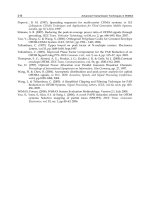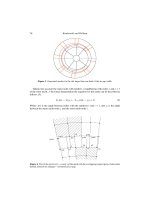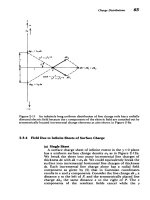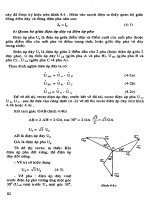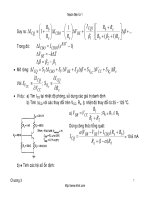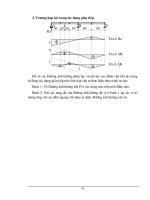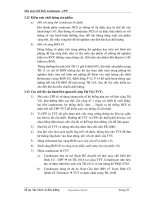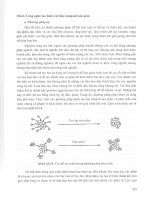Seamanship Techniques 2011 E Part 10 ppsx
Bạn đang xem bản rút gọn của tài liệu. Xem và tải ngay bản đầy đủ của tài liệu tại đây (556.22 KB, 40 trang )
63Meteorology
Tornado
A violent whirlwind about an area of low pressure, the tornado is most
common in the United States, where they have been known to create
considerable damage. The diameter of the whirlwind area is small, usually
50–200 m, but wind speeds may be in excess of 200 knots about the
centre. Actual wind speed in the centre is zero, but updraft may lift
objects into the air.
Trade Winds
Permanent winds which blow towards the equator, trade winds usually
measure between 3 and 5 on the Beaufort Scale. They are generally
referred to as NE Trades when they blow over the North Atlantic and
North Pacific from below latitude 30°N towards the equator, and SE
Trades when they blow from latitude 30°S towards the equator over
areas of the South Atlantic and the South Pacific.
Trough
This is an extension of low pressure from a low-pressure centre. It is the
opposite to a ridge, which is the outward extension from a high-pressure
centre.
Twilight
A period of reduced light which occurs after the sun dips below the
horizon, it is caused by the rays of sunlight being refracted in the atmosphere
towards the earth.
Veering
See ‘Backing’.
Vertex
The turning point in the path of a tropical revolving storm, the vertex
is the position in which the path of the storm moves to an easterly from
a westerly direction in the northern hemisphere.
Visibility
This is the maximum range at which an object is discernible. The state
of visibility may be assessed by using the length of the ship when in
dense or thick fog conditions. It may similarly be assessed when in poor
visibility by noting the time taken for an approaching vessel to become
visible, making due allowance for the respective speeds of the two ships.
When assessing good visibility, it is not good practice to use the range of
the visible horizon, owing to the possibility of distortion by refraction,
especially in misty or hazy conditions. Excellent visibility may be ascertained
when heavenly bodies are seen to be coming over or dropping under the
horizon when rising and setting.
Warm Front
This is a line of demarkation between advancing warm air and a mass of
cold air, over which the warm air is rising.
64 Seamanship Techniques
SE Iceland
Faeroes
Fair Isle
Viking
Bailey
Hebrides
Cromarty
Forties
Forth
Fisher
Tyne
Dogger
German
bight
Humber
Dover
Wight
Port-
land
Plymouth
Biscay
Finisterre
Sole
Shannon
Fastnet
Lundy
Irish
sea
Malin
Rockall
Thames
Figure 4.1 UK coastal forecast areas.
Waterspout
Caused by an extension, usually from a nimbus cloud, it will extend to
the surface of the sea, causing agitation of the water, which effectively
turns to a spout. The result is a column of water vapour, which may last
for up to half an hour. Shipping is advised to give it a wide berth.
Wave
A disturbance of the surface of the sea, a wave is caused by the wind.
Waves will vary in size and height. When a wave breaks on the coast line,
it is referred to as a ‘breaker’.
Wedge
A ridge of relatively high pressure, situated between two low pressure
areas, it is often roughly wedge-shaped.
65Meteorology
Wind
The movement of air parallel or nearly parallel to the surface of the
earth, the wind is named after the direction from which it comes.
FORECAST AREAS
Figures 4.1 and 4.2 map the UK coastal forecast areas and the weather
reporting stations respectively, and Figure 4.3 the North Atlantic areas.
WEATHER SCALES
Tables 4.1 to 4.3 cover the Beaufort Wind Scale and weather notation,
fog and visibility scale, and wave scale.
Sella Ness
Kirkwall
Kinloss
Stornoway
Tiree
Ronaldsway
Shoeburyness
Figure 4.2 Present weather – UK Coastal. Ships
requiring actual weather conditions around
the coastline of the British Isles can obtain
such reports from any of the Met Stations
shown. However, the stations may only be
manned during office hours or in the event
of a casualty risk being present. Sella Ness
has limited opening times.
66 Seamanship Techniques
CONSTRUCTION AND INTERPRETATION OF SYNOPTIC CHART
Meteorological offices around the world in many participating countries
collect and collate weather reports and related information for the benefit
of safe navigation. Weather reporting vessels, together with aircraft and
satellite pictures, provide reasonable forecasts for all major shipping areas.
The reports from all sources allow a comprehensive weather chart to
be produced. Symbols used are shown in Figure 4.4a.
The following information is typical of the normal weather report:
1. Position of reporting station, latitude and longitude.
2. Speed of reporting station (knots). Course of vessel.
3. Barometric pressure, correct for sea level. Indication of movement.
4. Weather description in Beaufort Scale notation (letter).
Figure 4.3 Sea areas and associated marine
communication areas effective
under the GMDSS operation.
67Meteorology
TABLE 4.1 Beaufort Wind Scale
Beaufort Wind Wave Height of Knots in
Scale description description sea in ft nautical
number mph
0 Calm Flat calm, mirror smooth – 0–1
1 Light airs Small wavelets, without crests 0.25 1–3
2 Light breeze Small wavelets, crests glassy 0.5 4–6
but not breaking
3 Light breeze Large wavelets, crests begin- 2.0 7–10
ning to break
4 Moderate Small waves, becoming longer, 3.5 11–16
breeze crests breaking frequently
5 Fresh breeze Moderate waves, longer with 6.0 17–21
crests breaking
6 Strong breeze Large waves, forming, crests 9.5 22–27
breaking more frequently
7 Strong wind Large waves, streaky foam 13.5 28–33
8 Gale High waves, increasing in 18.0 34–40
length, continuous streaking
of crests
9 Strong gale High waves, crests rolling 23.0 41–47
over, dense streaking
10 Storm Very high waves, overhanging 29.0 48–55
crests, surface white with foam
11 Violent storm Exceptionally high waves, 37.0 56–65
surface completely covered
with foam
12 Hurricane Air filled with spray, visibility – over 65
impaired
5. Air temperature.
6. Wind force and direction.
7. Sea state. Description of any swell.
8. Ice accretion.
9. Cloud cover and description.
10. Date and time of observation.
For ease of transmission, reports are coded by use of the Code and De-
Code Booklet, issued by the Meteorological Office and obtainable from
Her Majesty’s Stationery Office.
Once all the coded reports from stations in the area have been received,
decoding takes place, and the lowest barometric pressure is marked on
the weather chart at its point of observation. Due allowance is made for
the station’s course and speed from the time of observation to the
moment of reception. The term LOW is then recorded on the chart, and
isobars, joining places of equal barometric pressure, are sketched in lightly.
Arrows are then added to indicate wind direction. The mariner should
bear in mind that the arrows will generally cross the isobars in the
direction of the LOW. Speed of the wind in knots is indicated, together
with barometric pressure in numerical form. Wind speed used to be
indicated by the number of feathers attached to the drawn arrows, to
represent wind speed under the Beaufort Scale, but this practice is no
longer as popular as in the past.
68 Seamanship Techniques
TABLE 4.2 Beaufort weather notation
Symbol Meaning
b Blue sky with clear or hazy atmosphere, with less than one quarter of the sky
area clouded
c Cloudy with detached opening cloud, where more than three-quarters of the
sky area is clouded
bc Sky area clouded over between one-quarter and three-quarters of the total area
d Drizzle or fine rain
e Wet air with no rain falling
fFog
fe Wet fog
g Gloomy
h Hail
kq Line squall
l Lightning
m Mist
o Overcast sky
p Passing showers
q Squalls
r Rain
rs Sleet
s Snow
t Thunder
tl Thunderstorm
u Ugly threatening sky
v Unusual visibility
wDew
z Dust haze
TABLE 4.3 Wave scale
State of sea Height in metres
Calm – glassy 0
Calm – rippled 0–0.1
Smooth wavelets 0.1–0.5
Slight 0.5–1.25
Moderate 1.25–2.5
Rough 2.5–4.0
Very rough 4.0–6.0
High 6.0–9.0
Very high 9.0–14.0
Phenomenal over 14.0
Length of swell Length in metres
Short 0–100
Average 100–200
Long over 200
Height of swell Height in metres
Low 0–2.0
Moderate 2.0–4.0
Heavy over 4.0
69Meteorology
Symbol as used on printed chartsType of front
Quasi-stationary
Quasi-stationary, above
the surface
Warm
Warm, above the surface
Cold
Cold above the surface
Occlusion
Instability line
Intertropical
Convergence line
Warm airstream
(not in common use)
Cold airstream
(not in common use)
Figure 4.4(a) Symbols for fronts, as plotted on a synoptic
weather chart.
The letters of the Beaufort notation are added to describe the apparent
weather condition around the observer’s area, together with any relevant
information regarding storms, ice, fog etc. (see Figure 4.5).
CONTINGENCY PLANS FOR HEAVY WEATHER
1. Verify vessel’s position. Investigate safe port options.
2. Obtain up-to-date weather forecasts and expected weather
predictions, for surrounding areas.
3. Warn all departments of impending heavy weather.
4. Rig lifelines fore and aft.
5. Check following: anchors and securing, lifeboats and lashings,
watertight doors, and general cargo stowage and securing, especially
deck cargo lashings.
6. Close up ventilation, removing cowls where appropriate.
70 Seamanship Techniques
Figure 4.4(b) Maritime Rescue Co-ordination Centres
(MRCCs) are continuously manned
around the United Kingdom, together with
fifteen Maritime Rescue Sub-Centres
(MRSCs). All these stations may respond
to local weather conditions but such
information given would be only applicable
to present weather in the vicinity of the
station and would include forecasts for
other areas.
7. Check stability – no slack tanks.
8. Note preparations in log books.
9. Contact shore station, passing position and obtain constant plotting
of storm’s track.
10. Secure derricks/cranes and hatch covers.
11. Clear surplus gear from decks.
12. Close down deadlights.
13. Slacken off signal halyards and other relevant cordage.
14. Drain swimming pool.
15. Reduce manpower on deck by operating heavy weather work
routine.
16. Take down awnings.
17. Secure bridge for excessive pitching and rolling motion.
18. Warn engine room in plenty of time to reduce revolutions.
19. Check distress rockets and LSA gear.
20. Organise meal reliefs before bad weather arrives.
Yarmouth
Dover
Aberdeen
Clyde
Falmouth
Swansea
71Meteorology
EFFECTS OF HEAVY WEATHER ON VESSEL AT SEA
To describe the behaviour of any vessel in a heavy sea the mariner
should first be aware that every vessel, depending on her build, GM, state
of loading etc. will perform differently.
Stiff and Tender
A large GM will render a vessel stiff, i.e. give her a short period of roll,
and subsequent damage may be sustained by rapid rolling. A small GM
will render the vessel tender, i.e. she will have a long slow roll motion.
These two conditions, usually brought about by incorrect loading or
ballasting, should be avoided, so that unnecessary stress in the structure
of the vessel when in a seaway is avoided also.
Periods of Roll and Encounter
Period of roll may be defined as that time taken by a ship to roll from
port to starboard, or vice-versa, and back again. The ‘period of roll’ will
be to a great extent controlled by the GM of the vessel and by the
disposition of weights away from the fore and aft line.
Period of encounter may be defined as that time between the passage
of two successive wave crests under the ship.
If we consider the behaviour of a vessel with a short period of roll
compared to the period of encounter, then the vessel will tend to lie
Cross-section through Warm Sector Depression in Way of ‘AB’
Cumulonimbus
cloud (Cb)
Cold air
Precipitation
Cumulus cloud
(Cu)
8 km
20,000 ft
Cirrus
(Ci)
Cirrostratus
(Cs)
Thick
altostratus (As)
Thin
altostratus (As)
Warm air
Precipitation
Nimbostratus
(Ns)
Stratocumulus
(Sc)
Stratus
Precipitation
15,000 ft
6 km
4 km
2 km
5,000 ft
Cold air
10,000 ft
400 200 0 300 600
Miles
Northern hemisphere
Cold
air
Low
A
Warm air
B
Cold
air
Plan of depression
Figure 4.5 Interpretation of a synoptic weather chart.
72 Seamanship Techniques
Figure 4.7 Vessel with long period of roll compared to
period of encounter.
Figure 4.6 Vessel with short period of roll compared to
period of encounter.
with her decks parallel to the water surface or wave slope. The ship will
probably suffer violent and heavy rolling and may suffer damage because
of this. However, she will not generally ship a lot of water in this condi-
tion (see Figure 4.6).
If we consider the behaviour of a vessel with a long period of roll
compared to the period of encounter, then the vessel may be expected
to roll somewhat slowly and independently of the waves. The vessel will
probably experience only moderate angles of roll, and the waves may be
expected to break near the ship’s side (see Figure 4.7).
Synchronism
This is most dangerous and highly undesirable condition for a vessel to
experience and occurs when the period of roll is equal, or nearly equal,
to the half period of the waves. Successive waves tend to increase the
angle of roll of the vessel, producing the possible danger of capsize. It is
imperative that the watch officer should recognise the condition
immediately, especially in a small vessel, or when the range of stability is
small. An immediate alteration of the vessel’s course will effectively
change the period of encounter and eliminate the condition, which is
probably at its most dangerous when a beam sea is experienced and the
ship reaches a greater maximum inclination at each crest and hollow.
Cargo is liable to shift and the vessel will most certainly be damaged if
the condition is left uncorrected for any length of time.
Synchronised pitching – when the period of encounter is similar to
the vessel’s period of pitch – may also occur. This situation can be
alleviated by an alteration of speed, preferably a reduction, as an increase
may cause the vessel to ‘pound’. A vessel which has suffered engine failure
is most vunerable to synchronised rolling and efforts to bring the vessel’s
head into the wind should be made while she still has headway (headreach).
GENERAL BEHAVIOUR OF VESSELS IN HEAVY WEATHER
The options available to a vessel running into heavy weather can be
restricted to five main categories:
1. Head to sea, or with wind and sea fine on the bow, running at
reduced speed.
73Meteorology
2. Stern to sea, at reduced speed, running before the wind.
3. Heaving to, preferably in the lee of a land mass, to allow the weather
to pass.
4. Anchoring, depending on depth of water.
5. Altering course in plenty of time to take evasive action away from
adverse weather conditions.
It has been pointed out that the successful handling of any ship will be
dependent on the circumstances at the time and the characteristics of the
ship in question. Draught, state of loading, superstructure, turning circles
etc. will all influence decisions taken for the safety of the vessel.
Head to Sea (or with wind and sea fine on the bow)
This is probably the most favoured position for a deep-draughted vessel.
Leeward drift is minimised, but the vessel is liable to sustain considerable
punishment, owing to continual pounding. Should a vessel be designed
with increased scantlings, as for ice navigation, the concern might not be
as great as in, say, a vessel with no additional strengthening built in.
The object is to head the vessel into the weather, with the idea of
letting the weather pass over her. To this end, the speed of the vessel is
considerably reduced, which will affect the period of encounter of the
on-coming wave formations and subsequently reduce any pounding that
the vessel is experiencing. It may become necessary to stop the ship’s
engines on the approach of extremely heavy seas, effectively reducing all
headway. Courses and speed should be altered to remove the possibility
of hogging or sagging, and to prevent synchronism.
This situation can be a most uncomfortable one, with the vessel
pitching violently at times. Violent pitching may result in ‘racing propellers’,
which in turn puts excessive stress on engines. Absolute control of rudder
and power is essential. As a rule of thumb, power should be reduced to
the minimum necessary to maintain steerage way and avoid undue stress
on machinery. Two steering motors should be operational, if fitted, and
any zone of critical revolutions should be avoided.
Stern to Sea
Bad weather may often overtake the vessel at sea and she will effectively
find herself running before the wind. It is usual to take up a course with
the wind on the quarter rather than dead astern, this action tending to
make things more comfortable on board for all concerned. If the wind
and sea are acting directly from astern, then a vessel will run the risk of
a surf effect, as waves build up under the stern. In addition, vessels with
a low freeboard will run the risk of ‘pooping’.
Pooping occurs when a vessel falls into the trough of a wave and does
not rise with the wave, or if the vessel falls as the wave is rising and allows
the wave to break over her stern or poop deck area. Hence the name
‘pooping’, which may cause considerable damage in the stern area.
The mariner should consider the speed of the vessel in all conditions
of heavy weather, and what the effects of an increase or decrease would
74 Seamanship Techniques
be on the periods of encounter and the effective wave impact; but
generally the vessel’s speed should be eased down until she is handling
comfortably.
Generally speaking, the vessel with a following sea will not move as
violently as a vessel head to sea. Trial and error will determine an optimum
speed and minimise adverse motions of the ship. Speed adjustment,
together with the long peroid of encounter, will probably reduce wave
impact without any great delay to a ship’s schedule.
The main concern for a vessel with the wind and sea abaft the beam
arises if and when the vessel is required to turn. A distinct danger of
attempting to turn across the wave front is that the vessel may ‘broach
to’.
A following sea reduces the flow of water past the rudder, so that
steering may become difficult, and prevent the vessel’s head coming up
to wind. With reduced rudder effect, the vessel may be caught in an
undesirable beam sea and may ‘broach to’, being unable to come into the
wind and sea.
Heaving to
The prudent Master, after due consideration of all the circumstances,
might be well advised to take what may at first appear to be the easy
option. This may prove to be just that, with the wind blowing itself out
in a very short time. However, this is not always the case, and a Master
may encounter problems associated with crew fatigue or the spoiling of
cargo through heaving to for a lengthy period of time.
Obviously, circumstances must dictate the actions in every case, but if
it is possible to take advantage of a lee caused by some land mass, then
this can often be the answer to the immediate problem. This practice is
employed frequently in the coastal trades, especially with vessels carrying
cargoes liable to shift, e.g. roll on–roff off, grain etc.
If general heavy weather is encountered at sea, well away from coastlines,
the action taken by the Master will depend on the type and form of the
vessel. A reduction of speed will probably be one of the early actions to
reduce the motions of the vessel and eliminate the possibility of cargo
shift. Such reductions in the vessel’s speed should be limited, to permit
correct steerage under the adverse weather conditions. Power should not
be reduced to such an extent that stalling of the main machinery occurs,
nor should revolutions be allowed to oscillate about any critical zone of
revolutions for that type of main engine.
Another alternative under the heading of heaving to, is when it is
decided to stop main engines altogether. This action could result in
considerable drifting of the ship and sufficient sea room should be available
before the operation is begun. Heavy rolling can be expected, with the
ever present risk of synchronism and the real problem of shifting cargoes.
For this alternative to be successful, a vessel needs to have good
watertight integrity, together with an adequate GM. The use of storm
oil may become a necessity, once the vessel has taken up her own
position. Oil should only be used to maintain the safety of the vessel
75Meteorology
and/or life. It should be distributed on the windward side of the vessel,
in an amount sufficient to reduce the immediate hazards.
Spreading vegetable or animal oil on heavy seas will prevent wave
crests from breaking over the vessel but will have little or no effect on
the swell waves about the hull area. The use of mineral oils should be
avoided, especially if people are in the water. Lubricating oils are a
possible alternative but heavy fuel oils should be avoided at all costs.
The oil may be spread via the hawse pipes forward or by the scuppers
and/or toilet overboard discharges. Distribution via the hawse pipes is
particularly useful to any vessel engaged in a towing operation, for not
only will the tow gain the benefit of the oil but also the vessel towing.
Smaller craft, such as fishing boats and supply vessels, may need to use
oil in order to prevent the sea waves breaking over the vessel and ‘icing-
up’ taking place in the colder latitudes. Oil may require warming or
thinning down in very cold climates, and a suitable spirit may assist its
flow and distribution.
Should a decision be taken to use oil, then only enough to achieve
the objective should be employed. It should be remembered that large
waves which break and surf will effectively reduce and destroy the oil
film.
Use of Anchors
One of the greatest fears of any Master is that of being blown down on
to a lee shore. Many shipwrecks caused in this way could have been
avoided by anchoring in deep water, say 25–50 fathoms.
If the vessel is in shallow water, consideration should be given to the
use of two anchors, and the expected strain on cable(s). Many vessels
founder on a lee shore because they become disabled, loss of power
resulting in subsequent grounding, or insufficient power preventing them
from ‘beating out’ to seaward. The process of anchoring with or without
engine power will reduce the rate of the vessel’s drift to leeward. The
possibility of the anchors holding is a real one. Even if grounding is not
prevented, then refloating may very well be assisted by heaving on
cables.
Use of Sea Anchors
The idea of rigging an efficient sea anchor to keep the vessel head to
wind is feasible for a small vessel, if a sea anchor can be constructed easily,
but it is doubtful if any Master of a super tanker or even just a large vessel
would consider the idea. To be effective, the sea anchor would have to be
of an unmanageable size, even if the ship were equipped with the necessary
lifting gear and materials to make one, which is highly unlikely.
For small craft such as coasters and large yachts, a sea anchor will
reduce the lee drift, and keep the boat head to wind, but for the majority
of vessels it is a non-starter and they should consider other possibilities.
Any floating object that will offer reasonable resistance to the drift of the
ship will behave as a sea anchor, and mooring lines paid out over the
76 Seamanship Techniques
bow will sometimes be useful. Large ships, especially those having high
freeboard, would probably need outside help, such as a tug, in dangerous
situations.
The situation may be more appreciated if the mariner considered a
VLCC or ULCC ship, with small crew and little in the way of suitable
equipments for jury rigging.
TROPICAL REVOLVING STORM
The tropical revolving storm (TRS) normally forms in low latitudes,
usually between 7° and 15° north or south of the equator. It cannot
form in very low latitudes, or for that matter near land masses. These
storms are often called hurricanes, typhoons or cyclones, but to seafarers
they are all tropical revolving storms (see Figure 4.8).
Figure 4.8 Tropical storms.
1022
mb
1015
Alternative course of evasive
action
20°N
10°N
0°
15 km
10 km
5 km
Warm heat
reservoir
20°N
10°N
0°
Stratosphere
Tropopause
Preferred evasive
course of action
on the basis that if the storm is going to change course,
then the track of the centre will move north or north-east
Possible track
of centre
998
991
960
EYE
Dangerous
semicircle
Navigable
semicircle
Troposphere
Very heavy rainfall
Warm
air
Eye
15–30
miles
77Meteorology
A storm will develop over open seas where the temperature and
humidity are high, and some form of trigger action is available to set off
the violent convection. The storm is made up of intense asymmetrical
line squalls, which spiral inwards towards a central point, known as the
‘eye’. The eye of the storm will vary in size but is generally 15–30 miles
in diameter. This area is known to be a comparatively calm area, of
warm air from the sea surface, right up to the stratosphere.
Wind speeds are in excess of 64 knots and may reach as high as 200
knots, with gale force winds extending from the eye up to a range of 300
miles. The barometric pressure will be exceptionally low and may fall
below 900 mbs. A very high humidity level will be experienced, together
with very heavy rainfall in the area.
A tropical storm may take up to 5 days to form and reach a mature
stage, but once this stage is reached, it may take several weeks before it
dissipates. However, the normal period for a tropical storm’s life is between
one and two weeks. Should the storm move inland, the associated violent
weather can be expected to diminish within 48 hours of crossing the
coastline.
The general movement of a tropical storm will probably be in a
westerly direction, either in the northern or southern hemispheres. Speed
of movement will vary but the average is about 10 knots. Once clear of
the tropical latitudes, it is not uncommon for the track to move north or
north-east, or south or south-east, in the northern and southern
hemispheres, respectively.
Evasive Action
It is the duty of the Master of any vessel to report the position and
movement of any tropical storm if it has not already come to the attention
of the authorities. The eye of the storm should be plotted, together with
its rate of movement and probable path. Other dangers to the vessel’s
navigation should also be plotted in relation to the storm’s path.
The Master of any vessel should ascertain at the earliest possible
moment his own vessel’s position and which ‘semi-circle’ he is in or
entering. By full consideration of all the facts, a course of evasive action
should be taken as quickly as possible to avoid crossing the path of the
storm. Prudent use of the vessel’s full speed should be quickly made, as
it may become necessary to reduce speed later to avoid pounding and
damage to the vessel.
Obviously any Master faced with a tropical storm must make his
decisions on the particular case. It may become a practical proposition to
take up a satisfactory position and ride the storm out, letting the bad
weather move past the vessel. When making the decision on the type of
evasive action to take, Masters should bear in mind that tropical storms
have a general tendency to move towards the pole of whichever hemisphere
the vessel is navigating in. This, of course, is not inevitable, and a storm
has been known to double back on itself more than once.
Setting an evasive course towards the equator when on the predicted
track of the storm would seem to be the soundest action, provided that
the storm maintains its predicted movements.
78 Seamanship Techniques
ICE TERMINOLOGY
Anchor Ice
Submerged ice attached or secured to the bottom is known as anchor
ice.
Bare Ice
Ice without any snow covering.
Bergy Bit
A large piece of floating ice, this is between 1 m and 5 m above the
surface of the water.
Brash Ice
An accumulation of broken, floating ice, this contains pieces up to
approximately 2 m across.
Compact Pack Ice
A heavy concentration of pack ice, when no water is visible.
Compacted Ice Edge
A clear cut ice edge, this is generally found on the windward side of an
area of pack ice, compacted by the action of wind or current.
Concentration
A ratio expressing the density of ice accumulation, concentration is
expressed in tenths or oktas of the total area.
Consolidated Pack Ice
A concentration of 10/10, where the ice floes are frozen together.
Crack
This is a split or fracture in the ice surface, which has not parted.
Difficult Area
A general term used to describe the area as difficult for purpose of
navigation.
Easy Area
A general term used to describe the area as not too difficult for the
purpose of navigation.
Fast Ice
This is sea ice which has become ‘fast’ to the shore, ice wall or other
similar surface. It may be formed by the freezing of sea water close
79Meteorology
inshore or by pack ice freezing to the shore or other surfaces. Should its
height extend more than 2 m, it would be referred to as an ‘ice shelf ’.
First Year Ice
A term derived from young ice, being sea ice of not more than one
winter’s growth, this ice is between 30 cm and 2 m thick.
Flaw
A narrow dividing section between the pack ice and fast ice, a flaw is
formed by the shearing of the former from the latter.
Floating Ice
This general term is also used with regard to grounded or stranded ice.
Floe
This is a flat piece of ice more than 20 m across. Floes are sub-divided
according to size as giant, vast, big, medium and small.
Floeberg
A massive piece of sea ice, a floeberg made up of one or more hummocks
frozen together, the whole being separated from any other surrounding
ice.
Fracture
This general term is used to describe any fracture/break of unspecified
length. The width of the break is called:
large when over 500 m,
medium when 200–500 m,
small when 50–200 m, and
very small when less than 50 m.
Glacier
A continuously moving mass of snow and ice, a glacier moves from high
to lower ground or, when afloat, its mass is continuously spreading.
Glacierberg
An iceberg of irregular shape is given this name.
Grey Ice
Young ice up to 15 cm in thickness, grey ice has a tendency to break up
in a swell and will be seen to ‘raft’ under pressure.
Grounded Ice
Large or small pieces of ice gone aground/ashore in shoal water.
80 Seamanship Techniques
17. Small iceberg in open water of North Atlantic
(1984).
Growler
This piece of ice shows less than 1 m above the surface of the water. Its
volume is less than that of a ‘bergy bit’, and it usually has an area of
approximately 20 sq. m. As a growler makes a very poor radar target, it
is often very dangerous to navigation.
Hummock
A build-up of ice forced up by pressure is called a hummock, and a
similar build-up of broken ice forced downwards by pressure is referred
to as a ‘bummock’.
Ice Belt
A long pack ice feature, an ice belt is longer than it is wide. Length will
vary from about half a mile (1 km approx.) to more than 62 miles (100
km).
Ice Bound
When navigation in or out of a harbour is restricted by an accumulation
of ice, the harbour is said to be ‘ice bound’.
Ice Cake
A flat piece or cake of sea ice, less than 20 m across.
Ice Edge
This may be described as the dividing line between the open sea and the
limit of sea ice (ice boundary).
81Meteorology
Ice Field
Pack ice, composed of various sized floes in close proximity over an
unspecified distance greater than 10 km across (6.2 miles), is called an ice
field.
Ice-Free
Open water, clear of any ice, is ice-free.
Ice Patch
A quantity of pack ice, less than 10 km across (6.2 miles), is an ice patch.
Ice Shelf
This is a very thick layer of ice. An ice shelf could be up to 50 m above
the surface of the water, and of any length. The seaward edge is termed
an ice front.
Ice Tongue
A major ice projection from the coastline, this comprises several icebergs
joined by ‘fast ice’. Some or all of the icebergs may be grounded.
Iceberg
An enormous piece of ice more than 5 m in height above the surface of
the water, an iceberg originates from a glacier and may be afloat or
aground. When afloat, the greatest volume of the iceberg is beneath the
surface.
Lead
This is a visible fracture or passage which is navigable by surface craft
through the ice regions.
Level Ice
Flat sea ice unaffected by deformation is called level ice.
Multi-year Ice
This is ice which has survived for more than two summers without
melting. Its thickness is variable but generally up to about 3 m. It is also
practically salt-free.
New Ice
This term describes newly formed ice.
Nilas
A crust of thin ice approximately 10 cm in thickness, this often bends
with the swell and wave motion on the surface. It may be sub-divided
into dark nilas and light nilas.
82 Seamanship Techniques
Nip
The vessel is said to be nipped when ice under pressure is pressed into
the ship’s side; she is sometimes damaged in the process.
Open Pack Ice
This is a concentration of pack ice, of between four and six tenths coverage
with extensive leads and floes not in contact with each other.
Open Water
This term describes clear water free of obstruction ice and navigable to
surface craft, with ice concentration not exceeding one-tenth.
Pack Ice
A general term to include areas of sea ice, it does not include ‘fast ice’.
Pancake Ice
Circular pieces of ice up to 3 m in diameter and about 10 cm in
thickness, pancake ice curls up at the edges when pieces crash into each
other.
Rafted Ice
This is deformed ice caused by layers riding on top of each other.
Pressure changes cause the overriding, which is more often found in
young ice.
Rotten Ice
This is ice in an advanced state of decomposition, usually consisting of
light small pieces breaking up continuously.
Sea Ice
Ice formed from freezing sea water, found at sea, is called sea ice.
Stranded Ice
This is ice left ashore by a falling tide.
Tabular Berg
A flat-topped iceberg in the southern hemisphere.
Very Close Pack Ice
A concentration of pack ice between nine- and ten-tenths coverage is
described by this term.
83Meteorology
ICE NAVIGATION
In general, when a vessel has to advance through ice areas, the progress
of the ship will be dependent on:
(a) The nature of the ice.
(b) The qualities of the vessel, scantlings, ice breaker bow construction,
and motive power of machinery.
(c) Expertise and experience of the Master.
(d ) Operational qualities of navigational instruments.
(e) Assistance of tugs or ice breaker vessels.
( f ) Ice convoy facilities.
The Master of any vessel coming up to or approaching dangerous ice is
obliged by the International Convention for the Safety of Lift at Sea,
1960, to report any dangerous ice formation sighted on or near his
course. His ice report should contain the following information: type of
ice encountered; position of this ice; and GMT and date of sighting the
same. The Master is further obliged to proceed at a moderate speed or
alter his course to pass clear of ice dangers.
Ice reports are despatched to the International Ice Patrol, operated by
the United States Coast Guard throughout the ice season, usually beginning
about February and ending about June/July.
The prime function of the Ice Patrol is to warn shipping of the extent
of sea ice and icebergs which may aftect vessels on the main shipping routes.
Ice reports from shipping, together with weather reports from shipping,
assist the Ice Patrol to piece together any movement of ice, and allow the
construction of a facsimile chart of conditions for general broadcast to
all shipping within the area. Reports are made by the Ice Patrol twice
daily, together with the despatch of the facsimile chart. Additional reports
of ice sightings are broadcast whenever considered necessary. Transmitting
stations, together with frequencies and channels, are as described in the
Admiralty List of Radio Signals (see p. 10). Mariners should be aware that
this service is provided for them, and is greatly enhanced by their own
co-operation. Reports of actual sightings help the flight planning of Ice
Patrol aircraft and in designating patrol areas for surface craft.
Operating in Ice
Mariners entering ice regions should take early action to seek up-to-
date ice reports from the Ice Patrol, as distributed by the US Naval
Oceanographic Office. Ice limits should then be marked on to naviga-
tional charts, and any particular hazards, such as single icebergs, being
plotted. Course and speed of the vessel can then be adjusted accordingly,
circumstances dictating the safest route. A lookout is essential during
daylight hours, even in so-called good visibility.
Vessels without operational radar should be prepared to stop during
the hours of darkness if the concentration of dangerous ice warrants
such action, and should at any time proceed only at a safe speed. Ice
reports should be continually obtained and charts updated in accordance
84 Seamanship Techniques
with the vessel’s progress. A combination of fog and ice is not only a
dangerous combination but unfortunately a common occurrence.
Vessels attempting to negotiate ice regions should be equipped with
reliable engines and steering gear. It is an advantage if the ship is ice-
strengthened or longitudinally framed, with an ice-breaker bow.
It has been found by experience that ship-handling in ice can be
achieved by observing one or two basic principles:
1. The vessel must endeavour to keep moving into the ice and making
headway. Even if the movement is only very slight, it must be
maintained.
2. It is best for the vessel to move with the ice, not against it.
3. Maintain freedom to move, bearing in mind that excessive speed
lends itself to ice damage.
4. The mariner will require a great deal of patience.
Should the vessel become trapped in the ice and held, bear in mind
that freedom of movement is lost and the ship will then only move with
the ice, going wherever the ice is going. Should the forward motion of
the vessel be impeded, a movement astern should be considered as an
option, while searching for another ‘lead’ through the pack ice or ice
field. Continuous movement astern should be avoided because of the
very real danger to rudder and propeller. Continuous plotting of the
ship’s position in confined waters is essential at this stage in order to keep
the vessel clear of shoals and to prevent disorientation. Regular checks
on compasses and prominent landmarks must be considered essential.
The alternatives open to the Master are limited in the event of his
vessel becoming ‘ice bound’. Owners may decide to re-route the vessel
to another port, but, failing this, one or more of the following actions are
advised:
1. Assemble with other ships for movement in an ice convoy, usually
escorted by ice-breaker vessels.
2. Follow the track of an ice-breaker vessel, or ice-strengthened vessel
towards destination.
3. If equipped with an ice-breaker bow and also ice-strengthened,
attempt passage independently.
4. Before leaving port, add ice strengthening to the forepart of your
own vessel. (This can be done relatively quickly by building a
framework in the forepeak tanks out of pit prop beams, and covering
or filling the whole tank area with concrete. This construction may
later become permanent ballast for the vessel, as it is unlikely that it
could be easily removed without drydocking and cutting into the
shell plate.)
Ice Damage
The extent of any damage will depend on the condition of the ice the
vessel is passing through. The mariner should be prepared to accept some
damage to the vessel, while limiting the amount as much as possible.
85Meteorology
Severe wear of the outer shell plating will be experienced at the
waterline level, and for some height and depth above this level, according
to the thickness of the ice the ship is passing through. All paint work on
superstructures can be expected to flake and become badly pitted, especially
if the temperature is continuously below freezing for any period.
Denting of shell plates in the bow area must be anticipated. The stem
will be stripped clean of all paint and protective covering. The rudder
and propeller area is extremely susceptible to ice damage from large floes
passing down the ship’s side and colliding with the upper area of the
rudder and the rudder securing to the stock.
Lifeboat water tanks should be part emptied to avoid fracture. Steam
lines should be drained. Lagging on pipes should be regularly checked
for expected deterioration. Ballast tanks and fresh-water tanks should be
inspected daily to prevent freezing over.
18. Pack ice conditions.
5
PREVENTING COLLISIONS AT SEA
Collisions, it is hardly necessary to say, are a major hazard, particularly in
busy waters such as the English Channel. We shall list the International
Regulations of the International Marine Organisation (of which the UK
and USA are party to) interspersing them with numerous illustrations.
Marine students are advised that diagrams should, where appropriate,
be enhanced by colour, as a self-teaching aid, which would facilitate
learning.
INTERNATIONAL REGULATIONS FOR PREVENTING
COLLISIONS AT SEA, 1972
(as amended by Resolution A464(XII)) A626(15) A678(16) and A736(18)
PART A. GENERAL
RULE 1
Application
(a) These Rules shall apply to all vessels upon the high seas and in all waters
connected therewith navigable by seagoing vessels.
(b) Nothing in these Rules shall interfere with the operation of special rules
made by an appropriate authority for roadsteads, harbours, rivers, lakes or
inland waterways connected with the high seas and navigable by seagoing
vessels. Such special rules shall conform as closely as possible to these
Rules.
(c) Nothing in these Rules shall interfere with the operation of any special
rules made by the Government of any State with respect to additional
station or signal lights, shapes or whistle signals for ships of war and vessels
proceeding under convoy, or with respect to additional station or signal
lights or shapes for fishing vessels engaged in fishing as a fleet. These
additional station or signal lights, shapes or whistle signals shall, so far as
possible, be such that they cannot be mistaken for any light, shape or signal
authorized elsewhere under these Rules.
(d ) Traffic separation schemes may be adopted by the Organization for the
purpose of these Rules.
87Preventing Collisions at Sea
(e) Whenever the Government concerned shall determine that a vessel of
special construction or purpose cannot comply fully with the provisions
of any of these Rules with respect to the number, position, range or arc
of visibility of lights or shapes, as well as to the disposition and characteristics
of sound-signalling appliances, such vessels shall comply with such other
provisions in regard to the number, position, range or arc of visibility of
lights or shapes, as well as to the disposition and characteristics of sound-
signalling appliances, as her Government shall have determined to be the
closest possible compliance with these Rules in respect of that vessel.
RULE 2
Responsibility
(a) Nothing in these Rules shall exonerate any vessel, or the owner, Master
or crew thereof, from the consequences of any neglect to comply with
these Rules or of the neglect of any precaution which may be required by
the ordinary practice of seamen, or by the special circumstances of the
case.
(b) In construing and complying with these Rules due regard shall be had to
all dangers of navigation and collision and to any special circumstances,
including the limitations of the vessels involved, which may make a departure
from these Rules necessary to avoid immediate danger.
RULE 3
General Definitions
For the purpose of these Rules, except where the context otherwise requires:
(a) The word ‘vessel’ includes every description of water craft, including non-
displacement craft and seaplanes, used or capable of being used as a means
of transportation on water.
(b) The term ‘power-driven vessel’ means any vessel propelled by machinery.
(c) The term ‘sailing vessel’ means any vessel under sail provided that propelling
machinery, if fitted, is not being used.
(d ) The term ‘vessel engaged in fishing’ means any vessel fishing with nets,
lines, trawls or other fishing apparatus which restrict manoeuvrability, but
does not include a vessel fishing with trolling lines or other fishing apparatus
which do not restrict manoeuvrability.
(e) The word ‘seaplane’ includes any aircraft designed to manoeuvre on the
water.
(f ) The term ‘vessel not under command’ means a vessel which through some
exceptional circumstances is unable to manoeuvre as required by these
Rules and is therefore unable to keep out of the way of another vessel.
(g) The term ‘vessel restricted in her ability to manoeuvre’ means a vessel
which from the nature of her work is restricted in her ability to manoeuvre
as required by these Rules and is therefore unable to keep out of the way
of another vessel. The term ‘vessels restricted in their ability to manoeuvre’
shall include but not be limited to:
(i ) a vessel engaged in laying, servicing or picking up a navigation
mark, submarine cable or pipeline;
(ii) a vessel engaged in dredging, surveying or underwater operations;
(iii) a vessel engaged in replenishment or transferring persons, provisions
or cargo while underway;
